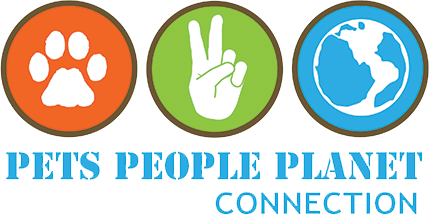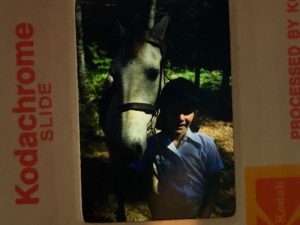
Diane, 10 years old, with horse
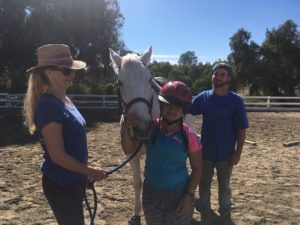
Kiana loving Onions
When I was a kid I rode horses. Mostly because my friends did, but I enjoyed it. I attended weekly lessons and competed in a few shows.
When we weren’t riding, my friends and I would set up jumps in one of our driveways and pretend to be the horse cantering through the course and jumping over the jumps- leaning our body forward, mimicking the position that we take on top of a real horse.
But then I stopped riding for a few different reasons and didn’t think much about it for years. As an adult, I’ve been involved with dogs, and rather focused on rescue and humane education. Yet over the past few years, I’ve become more aware of the myriad ways that animals help people. Dogs, as many of us know, can be amazing service animals. Be it as a guide dog for the blind or a different challenge, or as a therapy dog where they visit a patient or work as a service dog for people with PTSD, the list of applications goes on. In some cases the dogs are highly trained, in others, just their Being offers the support needed.
The same goes for horses.
It’s actually remarkable how horses can help people on an emotional or physical level or a combination of the two and there are multiple types of equine therapy available. I’ve read about how sensitive horses are and how they tune into our emotions, which is fascinating and beautiful and something, up until now, I hadn’t experienced myself.
So when an opportunity presented itself to do a service project for a class I’m taking, one of the projects I chose was working with an equine therapy organization called Ride to Fly.
Ride to Fly was building up their volunteer base so I checked it out and have been extremely impressed with this organization.
Honestly, I was a little afraid of horses when I was a kid (they are really big animals) despite my choice to ride them every week for years. Coming from this new curious perspective I wanted to witness equine therapy for myself. So I drove down to Rancho Palos Verdes (CA) and attended the mandatory orientation at the barn. I was so excited. I hadn’t been in a barn in years. Ok decades. It’s been a long time.
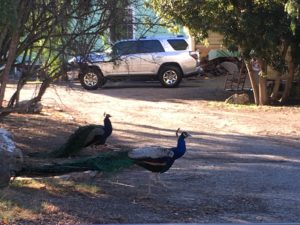
Wild peacocks
The barn is located on the hillside above the Pacific Ocean in Palos Verdes. It is picturesque and in the gated community on the way to Ride to Fly, you might find some bunnies and even a few wild peacocks (and coyotes I’m told)!
Upon arrival, I was greeted by the Executive Director, Gail, and the head instructor, Monique, (aka “Miss Monique”) who gave us an overview of their property and the program. From the Ride to Fly website: We are a non-profit organization dedicated to providing therapeutic horseback riding and the associated learning experiences to children and adults with disabilities in a safe, nurturing environment. We believe in the inherent worth and dignity of all people and wish to share the special gift of horsemanship with those with special needs. Ride to Fly is a PATH International (Professional Association of Therapeutic Horsemanship International) member operating center that has been serving the South Bay area since 1994.
First and foremost, they’ve created a quality program and want it to be a safe and pleasant experience for the riders. The variety of challenges the riders face run the gamut, from autism to Down syndrome, to cerebral palsy, anxiety, and many other conditions that compromise the student and can benefit from equine therapy.
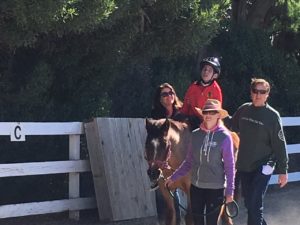
Jack with his parents sidewalking, Katie leading
In order for the riders to be safe atop the horse, each horse/rider team requires a team of 3 volunteers comprised of a horse leader who leads the horse around the arena, plus two side-walkers on each side of the rider. More advanced riders might not need both side walkers but for the most part, it is ideal.
The benefits of this program, among many, are the improved core and leg strength from riding a horse. Also, there’s something about the gentle side-to-side gait of the horse that centers and calms the rider.
During that first orientation, Monique shared a few stories about students who had been through the program and some of the benefits they were experiencing:
The first story was about a little girl who was previously non-verbal. Once she had been riding for a while, the dad shared: “I never thought I’d ever have a conversation with my daughter. But since she’s been riding, she now talks nonstop about the horses. Everything horsie. It’s remarkable.“
The second story was about a little boy who was physically challenged and couldn’t stand on his own. After riding at Ride to Fly for some time he first learned to steady himself and then called his dad in to see him standing without aid. The family credits Ride to Fly and his time on the horses for this remarkable feat.
And the third story is about a sweet little boy who fell off his horse a few weeks ago, realized he was on the ground, looked at the horse and decided that’s actually where he’s supposed to be, and walked right over to the horse and got back on. Totally fearless.
Crucial to the program is the calm demeanor of the horses as well. All of the horses are older and some are senior (horses typically live from 25-30 years) and most of the Ride to Fly horses are around 28 years old. What the teachers and program heads have experienced is watching a horse and witnessing the moment the horse realizes that the rider isn’t able-bodied. The horse instinctively knows it and their body language calms to meet the need of the rider. Amazing!
During the orientation, the potential volunteers first learned how to keep the rider safe. We got into the arena with Monique, a Lesson Aide named Katie who was the horse leader and another experienced volunteer who posed as a rider for us to practice with.
We learned how to do a thigh hold (gently but firmly placing an arm on their thigh) to help steady the rider, or for the more advanced rider, a shoe hold at the back of their shoe, just to give them a little extra confidence. We also learned how to do an emergency dismount. One side-walker releases the foot from the stirrup, tosses the reins out of the way, then assists the rider’s leg over the horse’s neck. Then the other side-walker wraps their arms around the rider’s waist and safely pulls them off and away from the horse.
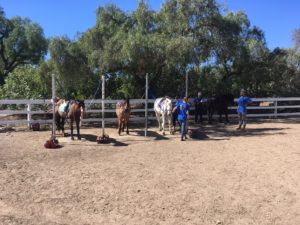
Four horses after lessons were done for the day
Emergency dismounts can be required for a variety of physical reasons, possibly due to a seizure, or the rider could be listing to one side from the heat to name a couple. More often, I understand, emergency dismounts are for disciplinary reasons when the rider isn’t, for example, abiding by the program rules.
After each potential volunteer got to practice the holds and emergency dismounts, we went over to meet and get up close with the horses. Ride to Fly has four horses and they have formed a little herd with a leader and followers. Prince Charming is the leader, Lulu is the mare who tries to get away with as much as she can, and Onions is one of the followers though he will, if you aren’t paying attention, grab at your shirt with his mouth. Their newest horse, Legacy, is a Tennessee Walker and was a show horse until a few months ago. He is still learning to slow down his gait to accommodate the challenged riders on his back.
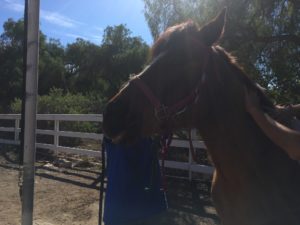
Grooming Closeup
To conclude the orientation, Gail, the Executive Director, who is absolutely lovely, reveled in how lucky she is to be a part of this program, spending her days in the beautiful Rancho Palos Verdes area at the barn, with the horses and the wonderful people who are attracted to Ride to Fly.
A few weeks later I was scheduled for my first official volunteer day. It was a brisk morning and we were happy to have the physical work of grooming horses, and helping get their tack (saddles and accoutrements) ready for the day. I don’t recall ever grooming a horse when I was a kid so it was wonderful to use the different brushes and groom their big bodies before the saddles were placed on their back for lessons. One of the other volunteers who has more horse experience than me offered to clean out the hooves and help place booties on Lulu’s feet.
I learned that day that not only is Monique a brilliant horsewoman, but she’s also extremely gifted with the students. She is firm and loving and knows what’s going on in their lives and easily engages with each person.
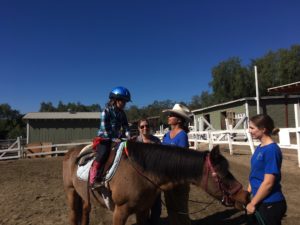
Fiona and Miss Monique connecting before the lesson
Our first lesson arrived and there would be two horse/rider teams in the arena at the same time. I was assigned to be a side walker with Cole, who is a charming 18 year- old young man. He would be riding Onions. And his riding partner, Adriana would be riding Prince Charming. Monique easily engaged with both Cole and Adriana as they were assisted in mounting their horses and she fixed their stirrup lengths.
Then the lesson began, and the students were gently asked by Monique “How do you tell your horse to go forward?” and the students replied: “Walk On,” and off we went. Cole’s face lit up with absolute joy as soon as we were moving, and I was struck by the beauty of the experience. Tears welled up in my eyes and then rolled down my cheek as I felt all of the love that was happening in this program. Thinking about everything that had to happen in order for this program to materialize, from acquiring the barn and appropriate horses, to having a board of directors, fundraising (because equine therapy is not yet covered by insurance or other funding) having a sufficient volunteer staff to support the program, and the incredibly dedicated teachers, Monique, Lea and the Lesson Aide, Katie who possess so many skills in both horsemanship as well as love and caring for the students.
I was grateful that I was wearing sunglasses and a hat and no one saw me crying at the time.
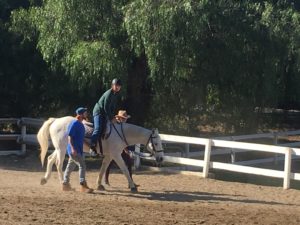
Cole- Two-point stand
The students practiced their two-point stands where they lean forward out of the saddle engaging their core and leg muscles. And they did a little bit of trotting all with the side walkers by their side. (I had never thought about jogging beside a trotting horse before but alas, I was able to do it!) Since it was a windy day that day, even though both riders are experienced and competent, they didn’t do any solo trotting without the aid of the horse leader- just in case the horses felt the excitement and energy of the brisk weather. Monique is very tuned in to the needs of both rider and horse.
At the conclusion of the lesson, Cole and Adriana got to comment on how the other rider did that day. This is standard and gives them an opportunity to both offer and receive praise from a classmate, which are invaluable skills.
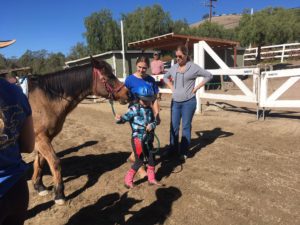
Fiona leading her horse over to her family
The next lesson pair was two super sweet, lovely young girls named Kiana and Fiona. Toward the end of the lesson, Fiona’s older brother who is severely challenged, joined the horses and riders, accompanied by his dad, for an opportunity to play a ring game where he names the color of the ring and then passes it gently to the next person. It’s just lovely that Ride to Fly accommodates the entire family.
In the next lesson, one of the students didn’t show up and the other side walkers stayed with the student that was in the arena. I joined Katie and the other volunteers who walked the horses that weren’t participating back to the area where they would either get a tack change or have their tack removed for the day.
Unfortunately, right next to the barn, some tree trimmers showed up with electric saws and started trimming the brush not 20 feet away from the horses. The horses got spooked and we had to ask the tree trimmers to wait until we weren’t so close before they started back up again. We moved the horses to the other side of that area so they wouldn’t be freaked out. Horses are prey in the wild and when they feel threatened they take off. We certainly wouldn’t want them to feel afraid or bolt, and we were grateful the people with the scary electric saws could accommodate us.
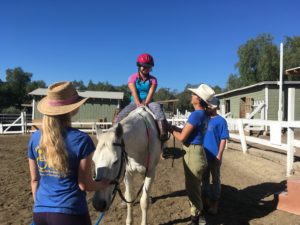
Kiana getting her stirrups adjusted by Miss Monique
Monique had shared with us on many occasions that she is dyslexic and often mixes up her right and left- including when she is instructing. On my second visit, while we were grooming the horses, she good-naturedly shared with us that at one time she was an instructor for able-bodied riders who showed horses. The problem is, with the dyslexia, she would often get the course confused and offer misinformation to the rider. While this might initially sound like a negative, it turns out that it’s a giant positive for Ride to Fly because they get the benefit of Monique’s tender, fun, direct and upbeat way with the kids and families, employees and volunteers.
During my second week volunteering, as one of the girls was mounting her horse, she told Monique that she had seen the movie Cinderella. Monique could instantly have a conversation about which version of the movie she had seen, the characters and more. Very impressive.
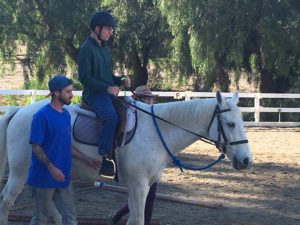
Cole solo
This day, it was much warmer and the students were able to do some trotting without the aid of the horse leader. They did some yoga poses on the horse, like upward dog and downward dog to stretch and strengthen their muscles and then squeezing their hands to strengthen hands and arms.
Once again, I was moved by all of the love present at the barn, to and from the horses, the participants, their families and more. I’m so honored to participate in this quality organization, even if my final job that day was to haul a bucket of manure…
Many thanks to Ride to Fly for the amazing gifts you give to people with challenges and their families. You are truly angels. And I am deeply grateful to the Ride to Fly families who agreed to allow me to take photos of their beautiful children to be used in this article.
If you would like to learn more about Ride to Fly and see what some of the participating families say about their experiences, please visit their website.
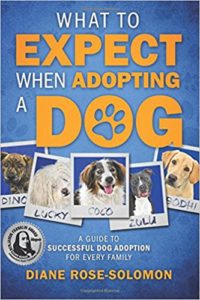 And if you are not in Southern California and would like to learn more about equine therapy in your area, please check out the PATH website.
And if you are not in Southern California and would like to learn more about equine therapy in your area, please check out the PATH website.
For more information about animal rescue and the human-animal bond, please visit my website.
